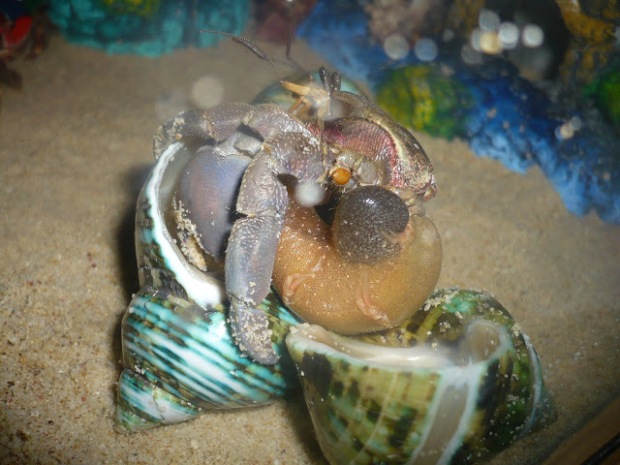Molting is the process every healthy crab goes through in order to grow. They bury themselves for several weeks to cast their exoskeleton and grow a new one.

Ref. a) Fuzzy post molt
Molting cycle is classified in four stages
- Proecdysis (Pre-molt)
- Ecdysis (molt)
- Metecdysis (post-molt)
- Anecdysis (inter-molt)
In order to pull a successful molt they need deep substrate. When they molt they emit a pheromone that attracts other crabs and signals they are easy to prey. Fortunately, they also emit signals which other crabs will work around to not interrupt them. Crabs with a nutritious diet will rarely feed on a molting crab.
Confirm commercial hermit food does not contain preservatives – ethoxyquin (often contained in fish flakes, hermit crab pellets, fish pellets, algae wafers, and most commercial food) or BHT. These are known molt inhibitors according to the EPA. Ethoxyquin is also contained in almost all foods ending in the word “meal” – i.e. hermit crab meal.
How do I know if my crab is about to molt?
Proecdysis Pre-molting symptoms (PMS). A few signs that a crab is about to molt are cloudy eyes, change in activity, massive consumption of food, shell changes, plenty of digging or extra time in the water pools. Crabs consume plenty of salt water to swell up and crack their hard exoskeleton, in order to molt. These can also be signs of normal behavior, in exception of cloudy eye. During this time, as always, do not handle them and leave them alone.

Ref. b) Black molt sac and engorged lower body.
You may spot a sac on the left of the abdomen, called a molt sac, which looks like a bubble. This is to store nutrients when they molt. At first the sac is translucent and gets darker as they get further in the pre-molt process, until it is nearly black and ready for a molt.
What happens when a crab molts?
Ecdysis. When a crab burrows down, they rarely stay in the same spot. They will usually dig tunnels or use established tunnel systems to find the perfect position where they feel safe. They will create a cave that provides insulation and darkness. Darkness is essential to release crustecdysone (molting hormone) and then they will begin the shedding. Here’s the cool part – crabs only perform mitosis, a.k.a cell division or growth, during the short period of an actual molt. Once a crab has found the perfect spot, they will dig a cave about 2-3 times their size. For this reason we suggest 7 – 10 gallons per crab, since their caves get spacious.

Ref. c) Molt cave with exo
They shed off their hard exterior called exoskeleton. The separation of old exoskeleton and epidermis is called Apolysis. They are soft and vulnerable underneath allowing them to stretch and grow. Afterwards their exterior hardens again growing a new exoskeleton. All this happens within 1 – 3 days, depending on the hermits size.

Ref. d) Hermit exoskeleton
Metecdysis (post-molt). Afterwards, the secretion of inactive molting fluid by epidermis. They will now consume the old exoskeleton that is rich in nutrients; producing a layer of cuticulin growing a new exo.

Ref. e) Before and after molt
Anecdysis, Several layers of shedding and growing continue. Lost limbs and eyes can also regenerate during a molt. It must not be disturbed. They are highly stressed and vulnerable. Molting is a very painful procedure. The hermit will surface when it is ready.
How do I care for my crab when it molts?
Nothing. DO NOT DIG. Under no circumstance should you pat down the substrate, compact, dig near or disturb it. Crabs can be molting for up to 9 months and sometimes molt twice before surfacing. Let them take their time. It’s a very severe process for them and they need privacy.
How can I tell if a crab has molted?

Ref. f) Hermit Claws
Crabs that come up from a molt have black, sharp tips on their limbs – sort of like claws! They will also be fuzzy. Males are fuzzier than females and if you look close enough you will observe eyelashes.
Keep the tanks temperature and humidity in suitable conditions. Refresh fresh and saltwater pools. Your hermit will want to bathe itself and most times change shells. Having a dish that cover every aspect from its diet. Proteins, calcium, fruit, plant litter, aquatic plants like seaweed, seeds and some treats. Organic honey is also a natural healing food and energy booster.
Hermits are still sensitive and often times crabby after a molt. Handling is not advisable immediately after a molt
For further information on molting visit Hermit Crab Owners/Molting and hermitcrabpatch.com
Images: a) Emily Coker; b) ilovehermitcrabs.com; c, d, e) Kristopher Woodward; f) Ceri Tremblay
